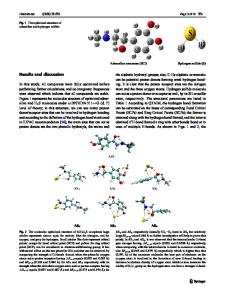Hydrogen Bond Research
- PDF / 19,504,222 Bytes
- 120 Pages / 595 x 794 pts Page_size
- 74 Downloads / 291 Views
Springer-Verlag Wien GmbH
Prof. Dr. Peter Schuster Institute of Theoretical Chemistry and Molecular Structural Biology, University ofVienna, Austria
Prof. Dr. Wemer Mikenda Institute of Organic Chemistry, University ofVienna, Austria
This work is subject to copyright. All rights are reserved, whether the whole or part of the material is concemed, specifically those of translation, reprinting, re-use of illustrations, broadcasting, reproduction by photocopying machines or similar means, and storage in data banks.
© 1999 Springer-Verlag Wien Originally published by Springer-Verlag Wien New York in 1999 Softcover reprint ofthe hardcover Ist edition 1999 Typesetting: Thomson Press (India) Ltd., New Delhi Printed on acid-free and chlorine-free bleached paper
With 44 Figures
CIP data applied for
Special Edition of MonatsheftejUr ChemielChemical Monthly, VoI. 130, No. 8, 1999
ISBN 978-3-7091-7320-6 ISBN 978-3-7091-6419-8 (eBook) DOI 10.1007/978-3-7091-6419-8
Contents Editorial ....................................................................................... ..............................
1
P Schuster, P Wolschann Hydrogen Bonding: From Small Clusters to Biopolymers ......... ................. .............
3
R. Konrat, M Tollinger, G. Kontaxis, B. Krautler NMR Techniques to Study Hydrogen Bonding in Aqueous Solution ........... ............ 17 A. Koll, P Wolschann
Mannich Bases as Model Compounds for Intramolecular Hydrogen Bonding II. Structure and Properties in Solution .......................................................................... 39 A. Simperler, W. Mikenda
Competitive Hydrogen Bonds and Conformational Equilibria in 2,6-Disubstituted Phenols Containing two Different Carbonyl Substituents ............ 59 A. Karp/en The Dimer of Cyanodiacetylene: Stacking vs. Hydrogen Bonding .................. ........ 73
K. Wolf, A. Simperler, W. Mikenda Proton Motion and Proton Transfer in the Formic Acid Dimer and in 5,8-Dihydroxy-l,4-naphthoquinone: A PAW Molecular Dynamics Study............... 87 E. Libowitzky Correlation ofO-H Stretching Frequencies and O-H···O Hydrogen Bond Lengths in Minerals.......................................... ......................................................... 103
Editorial The notion of the hydrogen bond has been invented at the beginning of our century and was used by Latimer and Rodebush in 1920, and independently by Huggins in 1922, to characterize a structural regularity in which a hydrogen atom is bound to two neighbors. Almost forgotten in the following 15 years, the hydrogen bond was brought again into the focus of interest when it was 'rediscovered' as a regularity in crystal structures. The development of efficient computational methods in quantum chemistry provided new tools for the analysis of intermolecular forces. This novel approach was used extensively in the seventies to develop a heuristic theoretical concept for the hydrogen bond which allowed to derive quantitative expressions for different contributions, like the electrostatic energy, exch
Data Loading...









